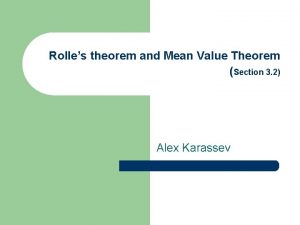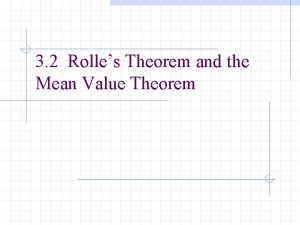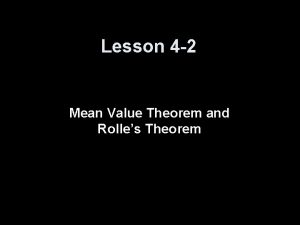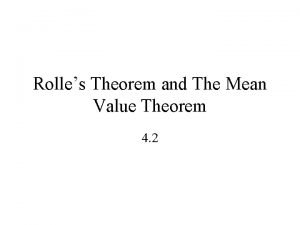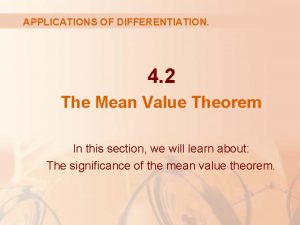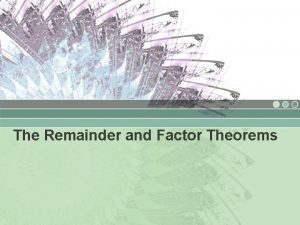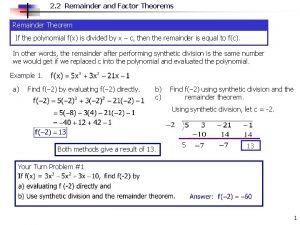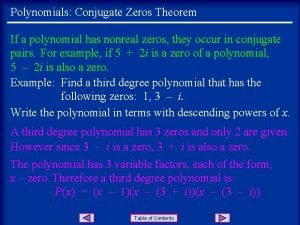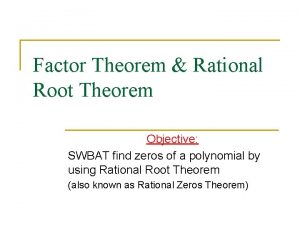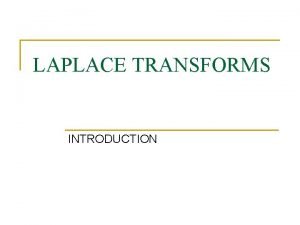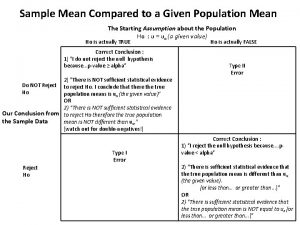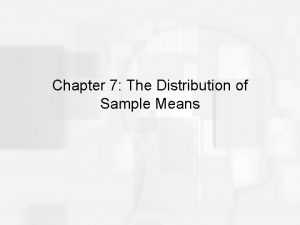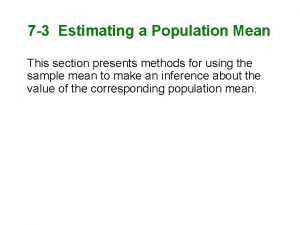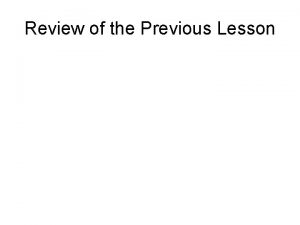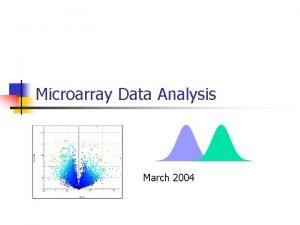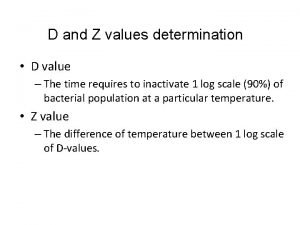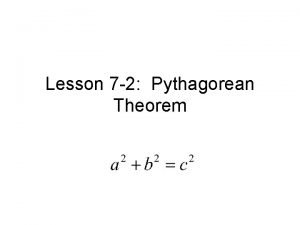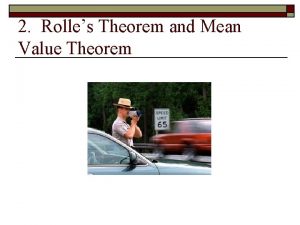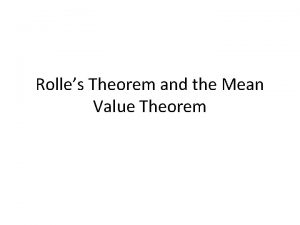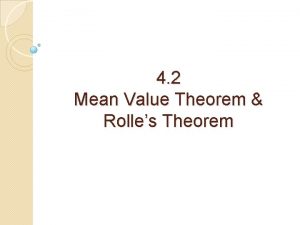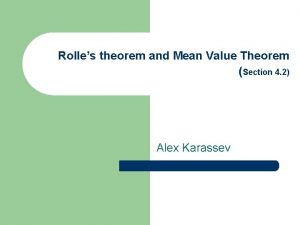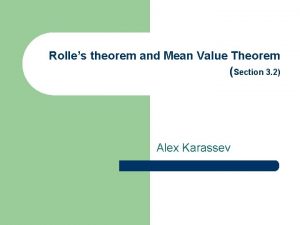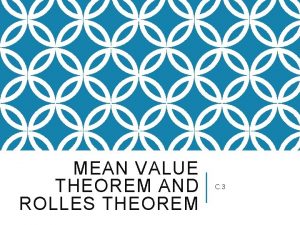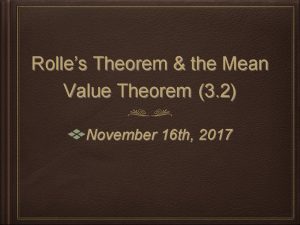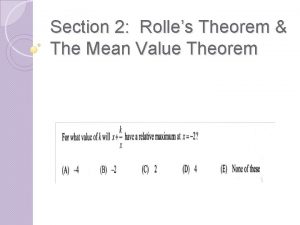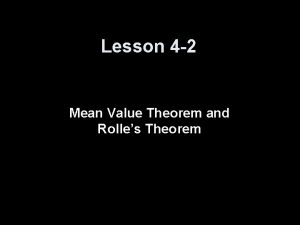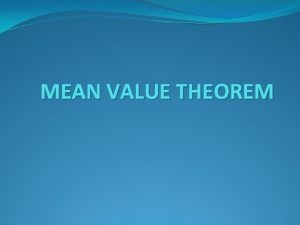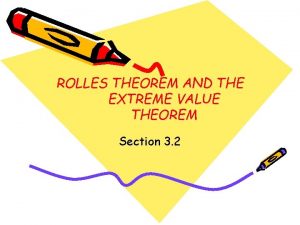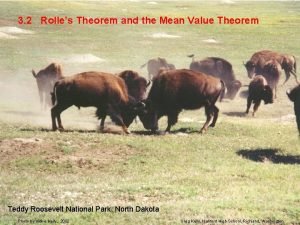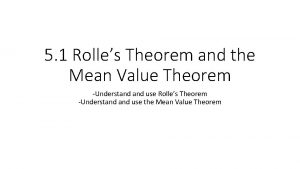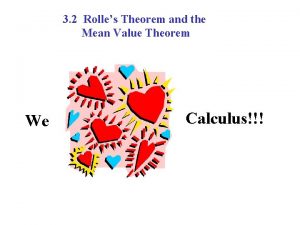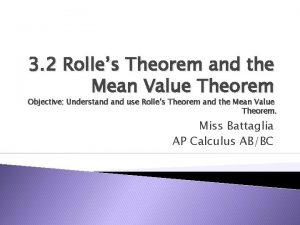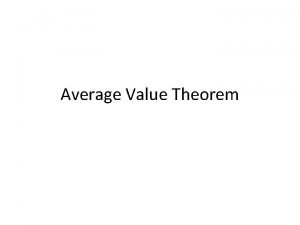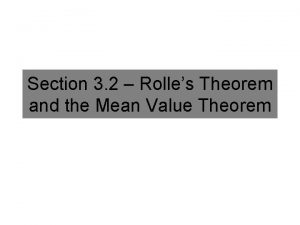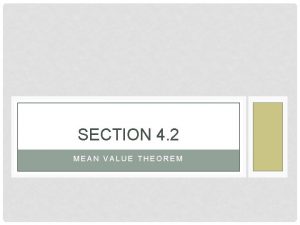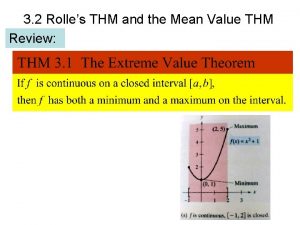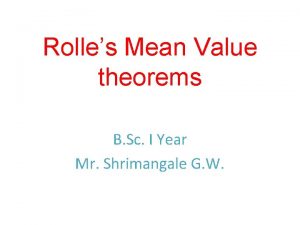Lesson 63 Rolles Theorem and the Mean Value






![Rolle’s Theorem If 1) f (x) is continuous on [a, b], 2) f (x) Rolle’s Theorem If 1) f (x) is continuous on [a, b], 2) f (x)](https://slidetodoc.com/presentation_image_h2/3cb7de27f095d54ed8c797fd8d5bbda7/image-7.jpg)




















![Example 2 2. Apply the MVT to on [-1, 4]. 28 Example 2 2. Apply the MVT to on [-1, 4]. 28](https://slidetodoc.com/presentation_image_h2/3cb7de27f095d54ed8c797fd8d5bbda7/image-28.jpg)
![2. Apply the MVT to on [-1, 4]. f(x) is continuous on [-1, 4]. 2. Apply the MVT to on [-1, 4]. f(x) is continuous on [-1, 4].](https://slidetodoc.com/presentation_image_h2/3cb7de27f095d54ed8c797fd8d5bbda7/image-29.jpg)
![Example 3 3. Apply the MVT to on [-1, 2]. 30 Example 3 3. Apply the MVT to on [-1, 2]. 30](https://slidetodoc.com/presentation_image_h2/3cb7de27f095d54ed8c797fd8d5bbda7/image-30.jpg)
![3. Apply the MVT to on [-1, 2]. f(x) is continuous on [-1, 2]. 3. Apply the MVT to on [-1, 2]. f(x) is continuous on [-1, 2].](https://slidetodoc.com/presentation_image_h2/3cb7de27f095d54ed8c797fd8d5bbda7/image-31.jpg)












- Slides: 43

Lesson 63 Rolle’s Theorem and the Mean Value Theorem HL Math - Calculus

After this lesson, you should be able to: Understand use Rolle’s Theorem Understand use the Mean Value Theorem

Rolle’s Theorem If you connect from f (a) to f (b) with a smooth curve, there will be at least one place where f ’(c) = 0

Rolle’s Theorem If you connect from f (a) to f (b) with a smooth curve, there will be at least one place where f ’(c) = 0 f(a)=f(b) a b

Rolle’s Theorem It just says that between any two points where the graph of the differentiable function f (x) cuts the horizontal line there must be a point where f '(x) = 0. The following picture illustrates theorem.

Rolle’s Theorem height If two points at the same _______ are connected by a continuous, differentiable function, then there least____ one has toat be place between those two points where the zero derivative, or slope, is _____.
![Rolles Theorem If 1 f x is continuous on a b 2 f x Rolle’s Theorem If 1) f (x) is continuous on [a, b], 2) f (x)](https://slidetodoc.com/presentation_image_h2/3cb7de27f095d54ed8c797fd8d5bbda7/image-7.jpg)
Rolle’s Theorem If 1) f (x) is continuous on [a, b], 2) f (x) is differentiable on (a, b), and 3) f (a) = f (b) then there is at least one value off isx continuous on (a, on [a, b] b), call it c, such that differentiable on (a, b) f(a) = f(b) f ’(c) = 0. a b

Example 1 : Does f(x) have any critical numbers between x = -2 and x = 2?

Example 1 ( f is continuous and differentiable) Since , then Rolle’s Theorem applies… then, x = – 1 , x = 0, and x = 1

Rolle’s Theorem Does Rolle’s Theorem apply? If not, why not? If so, find the value of c. Example 2

Rolle’s Theorem Does Rolle’s Theorem apply? If not, why not? If so, find the value of c. Example 3

Example 4 (Graph the function over the interval on your calculator) continuous on [-1, 1] not differentiable at 0 not differentiable on (-1, 1) f(-1) = 1 = f(1) Rolle’s Theorem Does NOT apply since

Rolle’s Theorem Does Rolle’s Theorem apply? If not, why not? If so, find the value of c. Example 5

Note When working with Rolle’s make sure you 1. State f(x) is continuous on [a, b] and differentiable on (a, b). 2. Show that f(a) = f(b). 3. State that there exists at least one x = c in (a, b) such that f ’(c) = 0. This theorem only guarantees the existence of an extrema in an open interval. It does not tell you how to find them or how many to expect. If YOU can not find such extrema, it does not mean that it can not be found. In most of cases, it is enough to know the

Rolle’s Theorem for Derivatives Example: Determine whether Rolle’s Theorem can be applied to f(x) = (x - 3)(x + 1)2 on [-1, 3]. Find all values of c such that f ′(c )= 0.

Rolle’s Theorem for Derivatives Example: Determine whether Rolle’s Theorem can be applied to f(x) = (x - 3)(x + 1)2 on [-1, 3]. Find all values of c such that f ′(c )= 0. f(-1)= f(3) = 0 AND f is continuous on [-1, 3] and diff on (1, 3) therefore Rolle’s Theorem applies. f ′(x )= (x-3)(2)(x+1)+ (x+1)2 f ′(x )= (x+1)(3 x-5) , set = 0 c = -1 ( not interior on the interval) or 5/3 c = 5/3

Apply Rolle's Theorem to the following function f(x) = x 3 – x on [0, 1] and compute the location c.

Apply Rolle's Theorem to the following function f and compute the location c.

The Mean Value Theorem Our main use of Rolle’s Theorem is in proving the following important theorem, which was first stated by another French mathematician, Joseph-Louis Lagrange. 19

The Mean Value Theorem We can see that it is reasonable by interpreting it geometrically. Figures 3 and 4 show the points A (a, f (a)) and B (b, f (b)) on the graphs of two differentiable functions. Figure 3 Figure 4 20

The Mean Value Theorem The slope of the secant line AB is which is the same expression as on the right side of Equation 1. 21

The Mean Value Theorem Since f (c) is the slope of the tangent line at the point (c, f (c)), the Mean Value Theorem, in the form given by Equation 1, says that there is at least one point P (c, f (c)) on the graph where the slope of the tangent line is the same as the slope of the secant line AB. In other words, there is a point P where the tangent line is parallel to the secant line AB. 22

(see Picture) The special case, when f(a) = f(b) is known as Rolle's Theorem. In this case, we have f '(c) =0. 23

Example 1 1. Apply the MVT to f (x) = x 3 – x on [0, 2]. 24

Example 1 - Soln To illustrate the Mean Value Theorem with a specific function, let’s consider f (x) = x 3 – x, a = 0, b = 2. Since f is a polynomial, it is continuous and differentiable for all x, so it is certainly continuous on [0, 2] and differentiable on (0, 2). Therefore, by the Mean Value Theorem, there is a number c in (0, 2) such that f (2) – f (0) = f (c)(2 – 0) 25

Example 1 - Soln Now f (2) = 6, f (0) = 0, and f (x) = 3 x 2 – 1, so this equation becomes 6 = (3 c 2 – 1)2 = 6 c 2 – 2 which gives (0, 2), so that is, c = But c must lie in 26

Example 1 - Soln Figure 6 illustrates this calculation: The tangent line at this value of c is parallel to the secant line OB. Figure 6 27
![Example 2 2 Apply the MVT to on 1 4 28 Example 2 2. Apply the MVT to on [-1, 4]. 28](https://slidetodoc.com/presentation_image_h2/3cb7de27f095d54ed8c797fd8d5bbda7/image-28.jpg)
Example 2 2. Apply the MVT to on [-1, 4]. 28
![2 Apply the MVT to on 1 4 fx is continuous on 1 4 2. Apply the MVT to on [-1, 4]. f(x) is continuous on [-1, 4].](https://slidetodoc.com/presentation_image_h2/3cb7de27f095d54ed8c797fd8d5bbda7/image-29.jpg)
2. Apply the MVT to on [-1, 4]. f(x) is continuous on [-1, 4]. MVT applies! f(x) is differentiable on [-1, 4]. 29
![Example 3 3 Apply the MVT to on 1 2 30 Example 3 3. Apply the MVT to on [-1, 2]. 30](https://slidetodoc.com/presentation_image_h2/3cb7de27f095d54ed8c797fd8d5bbda7/image-30.jpg)
Example 3 3. Apply the MVT to on [-1, 2]. 30
![3 Apply the MVT to on 1 2 fx is continuous on 1 2 3. Apply the MVT to on [-1, 2]. f(x) is continuous on [-1, 2].](https://slidetodoc.com/presentation_image_h2/3cb7de27f095d54ed8c797fd8d5bbda7/image-31.jpg)
3. Apply the MVT to on [-1, 2]. f(x) is continuous on [-1, 2]. f(x) is not differentiable at x = 0. MVT does not apply! 31

Example 4 4. Determine if the mean value theorem applies, and if so find the value of c. 32

Determine if the mean value theorem applies, and if so find the value of c. f is continuous on [ 1/2, 2 ], and differentiable on (1/2, 2). This should equal f ’(x) at the point c. Now find f ’(x). 33

Determine if the mean value theorem applies, and if so find the value of c. 34

35

Alternate form of the Mean Value Theorem for Derivatives 36

Example 5 Suppose that f (0) = – 3 and f (x) 5 for all values of x. How large can f (2) possibly be? 37

Example 5 - Soln Suppose that f (0) = – 3 and f (x) 5 for all values of x. How large can f (2) possibly be? Solution: We are given that f is differentiable (and therefore continuous) everywhere. In particular, we can apply the Mean Value Theorem on the interval [0, 2]. There exists a number c such that f (2) – f (0) = f (c)(2 – 0) 38

Example 5 – Solution so cont’d f (2) = f (0) + 2 f (c) = – 3 + 2 f (c) We are given that f (x) 5 for all x, so in particular we know that f (c) 5. Multiplying both sides of this inequality by 2, we have 2 f (c) 10, so f (2) = – 3 + 2 f (c) – 3 + 10 = 7 The largest possible value for f (2) is 7. 39

Example 6 Prove that the equation x 3 + x – 1 = 0 has exactly one real root. 40

Example 6 – Solution Prove that the equation x 3 + x – 1 = 0 has exactly one real root. Solution: First we use the Intermediate Value Theorem to show that a root exists. Let f (x) = x 3 + x – 1. Then f (0) = – 1 < 0 and f (1) = 1 > 0. Since f is a polynomial, it is continuous, so the Intermediate Value Theorem states that there is a number c between 0 and 1 such that f (c) = 0. Thus the given equation has a root. 41

Example 6 – Solution To show that the equation has no other real root, we use Rolle’s Theorem and argue by contradiction. Suppose that it had two roots a and b. Then f (a) = 0 = f (b) and, since f is a polynomial, it is differentiable on (a, b) and continuous on [a, b]. Thus, by Rolle’s Theorem, there is a number c between a and b such that f (c) = 0. 42

Example 6 – Solution But f (x) = 3 x 2 + 1 1 for all x (since x 2 0) so f (x) can never be 0. This gives a contradiction. Therefore the equation can’t have two real roots. 43
 Rollestheorem
Rollestheorem Rolle theorem
Rolle theorem Rolle's theorem
Rolle's theorem Khan academy intermediate value theorem
Khan academy intermediate value theorem Greene's theorem
Greene's theorem Mvtd
Mvtd Mean value theorem example
Mean value theorem example Penciptaan nilai adalah
Penciptaan nilai adalah Factor theorem
Factor theorem The remainder and factor theorems
The remainder and factor theorems Remainder theorem
Remainder theorem Linear factors theorem and conjugate zeros theorem
Linear factors theorem and conjugate zeros theorem Rational root theorem synthetic division
Rational root theorem synthetic division Linear factors theorem and conjugate zeros theorem
Linear factors theorem and conjugate zeros theorem Intermediate value theorem
Intermediate value theorem Laplace transform
Laplace transform Laplace transform formula
Laplace transform formula Sample mean and population mean
Sample mean and population mean Difference between mean and sample mean
Difference between mean and sample mean Example of population mean
Example of population mean Valrox
Valrox Calculate fold change
Calculate fold change D value and z value
D value and z value Ester value principle
Ester value principle Creating and capturing value
Creating and capturing value Lesson 7-2 the pythagorean theorem and its converse answers
Lesson 7-2 the pythagorean theorem and its converse answers Hát kết hợp bộ gõ cơ thể
Hát kết hợp bộ gõ cơ thể Lp html
Lp html Bổ thể
Bổ thể Tỉ lệ cơ thể trẻ em
Tỉ lệ cơ thể trẻ em Voi kéo gỗ như thế nào
Voi kéo gỗ như thế nào Chụp tư thế worms-breton
Chụp tư thế worms-breton Alleluia hat len nguoi oi
Alleluia hat len nguoi oi Môn thể thao bắt đầu bằng từ đua
Môn thể thao bắt đầu bằng từ đua Thế nào là hệ số cao nhất
Thế nào là hệ số cao nhất Các châu lục và đại dương trên thế giới
Các châu lục và đại dương trên thế giới Công thức tiính động năng
Công thức tiính động năng Trời xanh đây là của chúng ta thể thơ
Trời xanh đây là của chúng ta thể thơ Cách giải mật thư tọa độ
Cách giải mật thư tọa độ Làm thế nào để 102-1=99
Làm thế nào để 102-1=99 độ dài liên kết
độ dài liên kết Các châu lục và đại dương trên thế giới
Các châu lục và đại dương trên thế giới Thể thơ truyền thống
Thể thơ truyền thống Quá trình desamine hóa có thể tạo ra
Quá trình desamine hóa có thể tạo ra
